The lovely Ms. Sue Chin over at the Exhibits and Graphic Art Department at Bronx Zoo was kind enough to forward a couple of info sheets about the new Madagascar Exhibit. Instead of my summarizing for you, I am posting the sheets directly.
The first outlines the exhibit itself, from a content and experience point of view:
MADAGASCAR!
BRONX ZOO EXHIBIT FACT SHEET
HABITAT:
Madagascar! represents a dazzling reproduction of intriguing habitats on the world's fourth largest island, located off Africa's east coast and will highlight the extraordinary array of Madagascar's wildlife and the many threats and challenges to species conservation. The exhibit will delight guests with a display of colorful and exotic creatures from this "eighth continent" and inspire a conservation ethic by illustrating the threats to the island's biodiversity and the urgent need for WCS and others to protect its wildlife and wild lands.
EXHIBITS:
Only In Madagascar
This introductory exhibit to Madagascar! orients guests, through graphics and video, to the island's geography and distinctive assemblage of wildlife, the vast majority of which exist nowhere else.
Animals Exhibited: pinstripe damba
Conservation Trail
This path through the exhibit's rich interpretive experiences interweaves varied learning opportunities for guests to engage, both emotionally and intellectually, in the wonders of Madagascar and WCS's conservation activities.
Tsingy Cliffs
This dramatic entrance gallery features spectacular limestone cliff formations extending a full two stories high, a striking habitat for Coquerel's sifaka, a critically endangered species of lemur that inhabits the northwest forests of Madagascar. Sifakas have a unique mode of locomotion-- called vertical clinging and leaping-where they use their powerful hind limbs to leap from tree to tree.
Animals Exhibited: Coquerel's sifaka
Tsingy Caves
Drawing guests deeper into the exotic world of Madagascar, the Tsingy Caves introduces one of the island's most dramatic habitats: an underground limestone cave created by the eroding effect of rivers and seeps over thousands of years. As guests navigate the dim passageway, they will come upon giant Nile crocodiles.
Animals Exhibited: Malagasy killifish and Malagasy tree boa
Crocodile Pool
Placed at eye level, a 15,000-gallon tank in the Tsingy Caves brings guests face-to-face with a 13-foot-long giant Nile crocodile lying in wait for its prey in the darkness of the cave.
Small Wonders, Big Threats
This gallery introduces, at child's eye level, an array of living gems: tomato frogs, leaf-tailed geckos, rainbow fish and other fascinating creatures that introduce the diversity of Madagascar's wildlife. The exhibits is set into a high-tech surround "theater-in-the-round" with dramatic video portraying the island's animals in their native environments contrasted with scenes of habitat destruction and the threats to Madagascan wildlife.
Animals Exhibited: mouse lemur, lesser hedgehog tenrec, Malagasy killifish, white fin rainbowfish, tomato frogs, Madagascar giant day gecko, golden mantella, painted mantella, blue-leg mantella, and leaf tailed gecko.
Spiny Forest
In this gallery, the centerpiece of the exhibit, guests enter a bizarre arid forest of spiny trees found in Madagascar's dry south. There they encounter a diverse range of animals, including a dozen charismatic ring-tailed lemurs, a pair of brown lemurs, radiated tortoises, and two bird species: the Madagascar red fody and greyheaded lovebird.
Animals Exhibited: ring-tailed lemur, brown lemur, gray-headed lovebird, Madagascar red fody, radiated tortoise.
Baobab Tree
Within the Spiny Forest gallery, guests can step into a "cockroach tree," a fabrication of the oddly shaped baobab tree, where they will view a glass-enclosed collection of Madagascan hissing cockroaches.
Animals Exhibited: hissing cockroaches
Discovery Zone
At the central point of the Conservation Trail, this child-focused interactive area provides an opportunity for hands-on exploration through educational activities designed to spark curiosity and foster learning in Madagascar!
Observation Station and Tortoise Nursery
This interactive display brings guests inside a "WCS field hut" in the Spiny Forest for a close look at the science behind conservation. Here they can learn how scientists use observation of lemur behavior as part of conservation efforts in the wild. A pair of ring-tailed mongooses scamper around in this corner of the spiny forest, exploring their habitat. Guests can also view juvenile radiated tortoises, spider tortoises and two species of lizard.
Animals Exhibited: ring-tailed lemur, ring-tailed mongoose, radiated tortoise, four-lined plated lizard, spiny-tailed iguana, spider tortoise (aka pixie tortoise)
Masoala
A dramatic final gallery, here guests will experience a re-creation of the Masoala National Park, critically important to many of Madagascar's species and a site of WCS's field conservation efforts for more than a decade. A habitat formed around a cascading waterfall is home to a small group of vociferous red-ruffed lemurs, and a separate habitat hosts a pair of fossa, a unique mammalian predator found only on Madagascar.
Animals Exhibited: red ruffed lemur, fossa
Fossa Forest
Within the Masoala exhibit, guests will encounter a pair of animals rare in zoos. The fossa, the largest mammalian predator on Madagascar and a relative of the mongoose with catlike features, is one of the unique and threatened species of the island nation.
Animals Exhibited: fossa
Masoala Cascade
The Masoala gallery waterfall will flow into a 1,000-gallon elevated pool filled with colorful cichlids, unusual freshwater fish found in Madagascar.
Animals Exhibited: spotted damba, red-sided damba, saro cichlid, fony cichlid
Conservation Pathway
As guests depart Madagascar! and return to Astor Court, this pathway provides a final photographic opportunity in a reflective setting.
Great Hall
Featuring the historic architectural elements of the building, this grand 4,600-square-foot multi-purpose room in the Lion House is the largest indoor meeting and event space at the Bronx Zoo. The refurbished century-old trusses, two-story windows and ornamental animal sculptures are visible to guests assembled for WCS meetings, community events and private functions in this flexible and fully accessible venue with a seating capacity of 230 people.
Executive Meeting Room
This glass-enclosed meeting space within the Great Hall provides a bird's eye view of the dramatic architecture of the Lion House, including a close look at the interior sculptures and other historic architectural features. This upper level room affords a flexible space for use by WCS and community groups.
Lion Garden
This courtyard along the west side of the Lion House enhances the historic architecture of the building's exterior. The sentinel lion sculptures, relocated from their original placement at the Lion House's south entrance, are the new focal points of the garden.
SIZE: Total Square Footage: 41,354 sq. ft.
Basement: 20,765 sq. ft.
First Floor: 18,648 sq. ft.
Mezzanine: 1,941 sq. ft.
EXHIBIT DESIGN: Exhibition and Graphic Art Department, Wildlife Conservation Society
Film and Video Production: Archipelago Films
Media Design: Unified Field
Bronze Sculpture: Priscilla Deichmann
Life Support System Design: TJP Joel Johnson
Illustration: Lawrence Richardson
ARCHITECTURE:
Architect: FXFOWLE Architects, New York, NY
Structural Engineer: Chris Anastos, P.E.
Mechanical Electrical Plumbing (MEP) Engineer: Kallen & Lemelson Engineers
Landscape Architect: Quennell Rothschild & Partners
Historic Preservation: Building Conservation Associates, Inc.
Lighting Consultant: Hayden McKay Lighting Design -
Acoustic Consultant: Cerami Associates
Geotechnical Engineer: Langan Engineers
Code Consultant Expediter: Design 2147 Limited
AV Consultant: DVI Communications Inc.
CONSTRUCTION:
NYC Department of Design and Construction
Construction Manager: Hill International
EXHIBIT CONTRACTORS:
Habitat Fabrication: Cost of Wisconsin
Graphics Fabrication: Dimensional Communications Inc
Exhibit Murals - Dave Rock
The second is all about the project as an historic restoration and green project:
BRONX ZOO LION HOUSE RESTORATION
HISTORY
The Wildlife Conservation Society has rededicated the spectacular architectural legacy of the Bronx Zoo's Lion House exhibit. The structure is over 100 years old, built in the popular French beaux-arts style of that era, an elaborate and highly decorative form that emphasizes dignity, symmetry and the infusion of diverse influences from the past. It is the largest of six buildings comprising the Bronx Zoo's Astor Court, and has served as the temporary home of the New York Aquarium, a meeting place for the National Guard during World War II, a home for the Zoo's big cat exhibit for many years and as the site where the groundbreaking 1905 decision was made to rescue America's rapidly-shrinking bison population.
Situated at the heart of the Zoo, the Lion House was designated a Historic District by the New York City Landmarks Commission in 2000 in recognition of its aesthetic and historic distinction. The 20,000-square-foot building, which opened in 1903, is a jewel of Beaux Arts architecture and will be the site of a magnificent new exhibit, Madagascar!, and of the Schiff Family Great Hall, a spacious community meeting and event facility. Its design addresses the functional demands of the future and incorporates new advances in animal welfare, visitor experience, conservation awareness, and science education.
GREEN DESIGN
It is anticipated that the building will carry the distinction of being the first landmarked building in New York City to be certified "green" by the U.S. Green Building Council. It represents the next generation of the Zoo experience, function as a publicly accessible building and exemplifies the Wildlife Conservation Society's mission of conservation - an integrated exploration of fit and form, aimed towards environmental, social, and economic sustainability. The greatest challenge was to design and restore a historic structure that not only met mixed use programmatic and functional goals, but also met the US Green Building Council's LEED (Leadership in Energy and Environmental Design) standards. An integration of sustainability into the design concept is the key to the success of all aspects of this project; a local materialization of the Wildlife Conservation Society's global conservation efforts and a model for future development. The contained, right-sized mechanical systems contribute to a healthy and sustainable environment for the animals, handlers and visitors with high standards of interior environmental quality These and many other sustainable advancements contribute to an anticipated LEED Gold Rating, including:
Site
• Site selection and building design are part of a comprehensive master plan. The building rehabilitation and its central location insure the use of a formerly empty building which had become obsolete for animal exhibits.
• Maintain integrity of historic building and surrounding landmark district while incorporating modern exhibits and systems.
• Cultural enhancement of the Bronx Zoo campus through historic preservation and creation of a new popular destination in a previously underused area.
• Reinforce WCS mission for sustainability in a publicly visible area at the original center of the zoo complex.
Energy
• Fuel cell for generation of building electricity with connection back into campus cogeneration system.
• Use of waste heat to reduce size of building systems and connection to campus waste heat loop.
• Geothermal heating and cooling systems to reduce consumption of fossil fuels.
• Extensive use of dynamic skylight system to maximize daylight and modulate temperature in exhibits.
• Increase acceptable temperature range within building to reduce equipment size.
• The Lion House has a 57% savings in energy cost over an Energy Code compliant equivalent.
Water
• Use of waterless urinals and low flow plumbing fixtures to reduce water consumption for building occupant and public toilets used by thousands of visitors per day.
• Wastewater reclamation through grey water system for lavatories.
• Inclusion of water filtration system for adjacent sea lion pool to eliminate regular water changes.
• The Lion House has a 59% savings in water consumption and 30% savings in waste water.
Systems + Materials
• Fully integrated building management system to control all aspects of the building environment.
• Use of low-impact materials: recycled steel, slag concrete, FSC certified wood.
• Use of high-performance building systems: ETFE dynamic skylight system to control sunlight and modulate heat loss and heat gain.
• Location of construction within campus eliminates traffic impacts.
• Construction waste management program to minimize waste generation, reuse materials and recycle waste.
• Conservation of materials and resources: preservation of building shell; salvage and reuse of existing brick and stone to eliminate need for any new face brick.
• Reduction in the building's ecological footprint (e.g. minimizing materials, space efficiency, limiting impact on the ecosystem.)
Indoor Air Quality
• Building Management system controls natural and mechanical ventilation as appropriate to interior and exterior temperature and humidity.
• Operable windows and skylights.
• Low pressure under-floor air distribution system.
• Carbon dioxide sensors.
• Use of low and no VOC emitting materials.
DESIGN
Led by FXFOWLE Architects, a cadre of consultants expert at historic preservation, acoustics, green architectural practices, food services and event space use make up the team for the restoration. A complex design process included participants from landmarks and historic preservation, NYC Department of Design and Construction, NYC DDC Office of Sustainable Design, New York Power Authority and WCS's exhibit designers and plant and animal curators.
The core project goals were: to restore a historic structure; to adapt the architecture to address the new exhibit and event space program needs; and to meet the sustainable design principles that reflect WCS's mission. The Lion House required major infrastructure work to meet these goals.
The new program for the Lion House scope spans from cellar to ceiling, expanding the usable area from 32,000 to 41,000 square feet by increasing the basement in width and depth and by inserting an interior mezzanine. This program calls for the building to have two separate, but interconnected functions. The first function is as a dynamic animal exhibit dedicated to the beautifully exotic animal and plant life of Madagascar.
The second is the Schiff family Great Hall, a multi-use space that will host staff lectures, educational activities, art exhibitions, conservation conferences and other public events. The space will also be made available to the community for local needs such as Community Board meetings.
Comprehensive restoration and cleaning of the brick façade, decorative friezes, limestone sculptures and wrought iron elements along with the replacement of the roof, downspouts and gutters, windows was necessary to return the building envelope to its original splendor. New Foiltec skylights retain the historic quality of the building yet address the needs of the new exhibit by allowing lots of natural daylight and ultra violet light for the animals and plants. Completely new HVAC, plumbing and electrical systems were designed to meet the complex needs of the animal exhibits as well as the Great Hall. A new geothermal system, along with a fuel cell funded by the New York Power Authority are prime examples of the green technology included in this project. The interior of the building required complex interior demolition, stabilization and replacement of floor structure, walls and building structure; and modifications to enable adaptive re-use for living collections. The landscape design includes an outdoor terrace to the west of the building. This terrace is the new home for the historic sentinel lions that were originally located at the South entrance to the building. In addition, the restoration includes installation of a fire protection system, the building of new service access, and the building complies with ADA requirements and general building and energy codes, including the installation of ADA compliant restrooms.
This construction project also includes two types of skylights. Traditional skylights have been installed over the corridors for visitors, public spaces and a mezzanine level conference room. WCS is also using a thermoplastic foil layering system called Foiltec for nearly 8,500 square feet of skylight space, which will balance the contradictory requirements of allowing maximum natural light with minimum heat gain. The Foiltec system has very good insulation value and uses special technology to connect to the HVAC for further temperature regulation efficiency. Foiltec is unique in that it transmits ultra violet light, which is vital to the animals and plant life in the Madagascar! exhibit. With this restoration, the Lion House returns to its earlier architectural glory, providing the public with an important destination for new exhibitions and educational program.
Opening date of the exhibit is June 19, 2008.












 Recently opened Dubai Aquarium, inside the gargantuan Dubai Mall, set the new Guiness World Record for "World's Largest Acrylic Panel" this November.
According to Emaar Malls, the Dubai Mall developer, the panel measures "32.88 metres wide x 8.3 metres high x 750 mm thick...weighing 245,614 kg, the viewing panel at Dubai Aquarium surpasses the current Guinness World Record holder, Churaumi Aquarium in Okinawa, Japan, at 22.5 metres wide x 8.2 metres high and 600 mm thick."
Recently opened Dubai Aquarium, inside the gargantuan Dubai Mall, set the new Guiness World Record for "World's Largest Acrylic Panel" this November.
According to Emaar Malls, the Dubai Mall developer, the panel measures "32.88 metres wide x 8.3 metres high x 750 mm thick...weighing 245,614 kg, the viewing panel at Dubai Aquarium surpasses the current Guinness World Record holder, Churaumi Aquarium in Okinawa, Japan, at 22.5 metres wide x 8.2 metres high and 600 mm thick."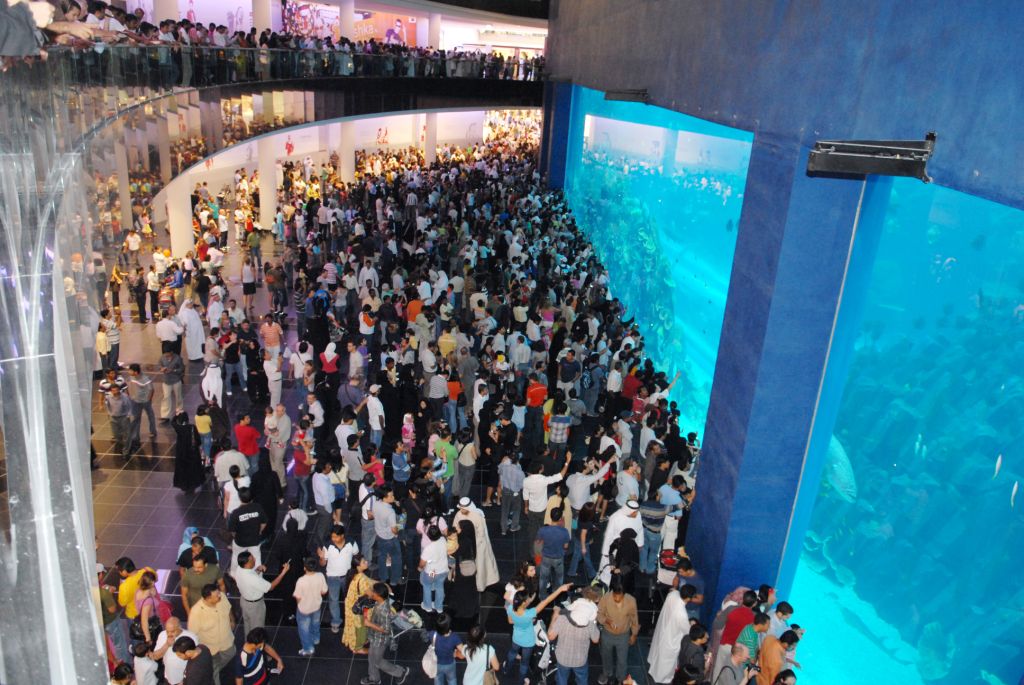
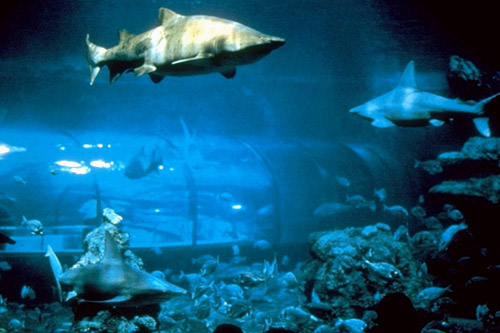








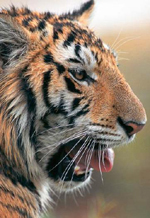


























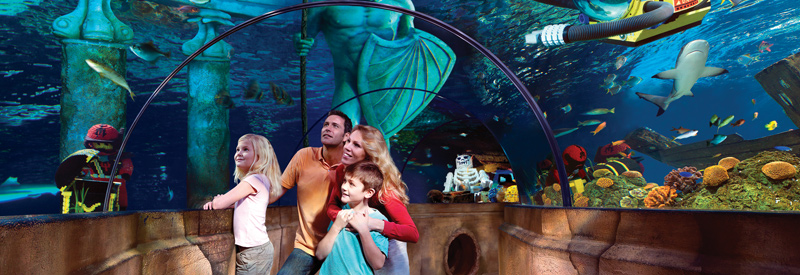
















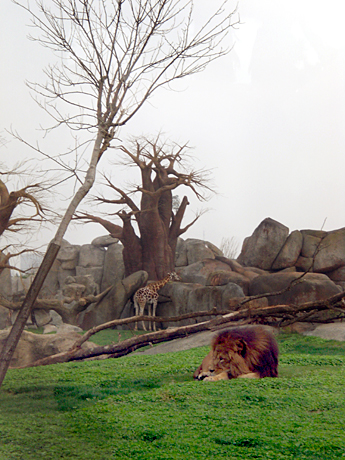


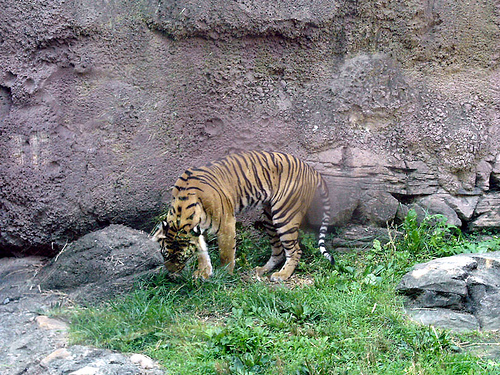

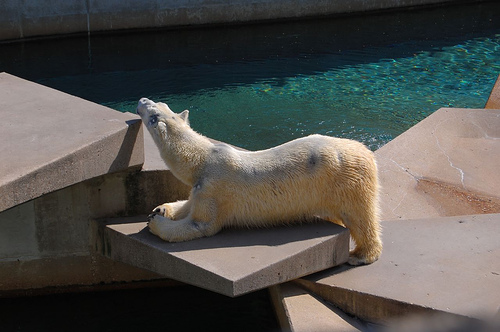


 To help avoid the critical eye of animal activists such as
To help avoid the critical eye of animal activists such as 











 Here
Here Bronx Zoo tackles another great project in this adaptive reuse of the historic Lion House. The issue of reuse in zoos is near and dear to my heart (see Messages and Meanings Part 1) as I believe some of the most beautiful aspects of zoos are their historic buildings (aside from the critters themselves!). Oftentimes, a critical mistake occurs with the juxtaposition (yes, I did just write that) of natural exhibit design with the human-dominant structures. Generally, the best use of these buildings is, in my opinion, a change of use; meaning, a cat house becomes the new restaurant.
In this case, the Bronx decided to change the style of exhibit and species held within, but keep to the original use of 'animal home'. I'm hoping that this project is another example of successful reuse, and can't wait to see the finished product! Maybe I'll be able to get the scoop on the design process and decision-making, and post for all to see. Keep an eye out...
Bronx Zoo tackles another great project in this adaptive reuse of the historic Lion House. The issue of reuse in zoos is near and dear to my heart (see Messages and Meanings Part 1) as I believe some of the most beautiful aspects of zoos are their historic buildings (aside from the critters themselves!). Oftentimes, a critical mistake occurs with the juxtaposition (yes, I did just write that) of natural exhibit design with the human-dominant structures. Generally, the best use of these buildings is, in my opinion, a change of use; meaning, a cat house becomes the new restaurant.
In this case, the Bronx decided to change the style of exhibit and species held within, but keep to the original use of 'animal home'. I'm hoping that this project is another example of successful reuse, and can't wait to see the finished product! Maybe I'll be able to get the scoop on the design process and decision-making, and post for all to see. Keep an eye out...


















